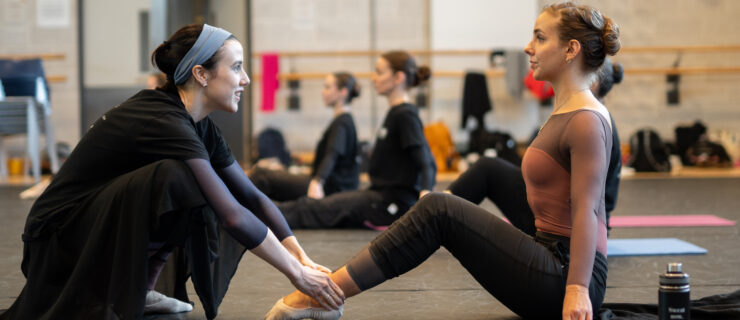Semi-Pro Limbo: Breaking Into the Professional Ranks From a Second Company or Trainee Program is Taking Longer Than Ever
This story originally appeared in the April/May 2016 issue of
Pointe.
After two years as a trainee and then one as a second company member at Orlando Ballet, 22-year-old Aurélio Guimarães wasn’t able to audition much due to an injury. When The Washington Ballet offered him another traineeship, Guimarães debated what to do. He would ultimately be embarking on a fourth year of doing professional work without a livable salary or title. “It was absolutely a hard decision,” Guimarães reflects. “But I also had to consider the work that I would be doing.” Knowing his traineeship would entail close work with the artistic director, he essentially took a demotion, with the hope that starting over in Washington would yield a paid contract at the end of the year.
In the past, it was common for a year or two of apprenticeship to lead directly to a corps contract. But today’s ballet world involves more no- to low-paying rungs at the bottom of the ladder. Many companies now have three gatekeepers: trainee programs that are often the top level of the school and involve corps work with the company; second companies that work independently as well as more intimately with the main company; and apprenticeships, the most entry-level rank inside the professional hierarchy.
While these positions are necessary opportunities for young dancers to gain experience and build their resumés, they are made to be temporary, generally lasting two years. Most companies are only able to promote one or two dancers out of these ranks every season. With the number of trainees and second company members growing, the possibility of making it to the next level has become more limited. As a result, more young dancers find themselves stuck in this netherworld, moving from one semi-professional contract to another and spending a large chunk of their careers in the minor leagues. For young—and sometimes not so young—dancers, it is becoming harder to know whether paying their dues will ever pay off.
 Members of Nashville Ballet’s second company in “Peter Pan.” Photo by Marianne Leach, Courtesy Nashville Ballet.
Members of Nashville Ballet’s second company in “Peter Pan.” Photo by Marianne Leach, Courtesy Nashville Ballet.
Climbing the Ladder
Trainee programs and second companies are often marketed as an even exchange: Young dancers gain professional training and performance experience while cash-strapped companies can expand their corps de ballet onstage, allowing them to draw bigger audiences with full-length story ballets and larger neoclassical and contemporary works.
They also allow directors to groom potential company members. At Nashville Ballet, 70 percent of the main company dancers have gone through its second company, which is typically a two-year system. Artistic director Paul Vasterling will sometimes offer a second-year NB2 dancer the option for a third year when he wants to hire them but doesn’t have a company position available. NB2 also allows him to coach dancers in the company style and bring up the technical level of the corps. “It provides an ethos for the way they move,” says Vasterling. “We toured to St. Louis recently and the comment I got—’They move so well together’—is simply because they have been together a long time, a continuum of dancers from the low ranks into the principals.”
BalletX dancer Caili Quan found her early years of career building beneficial. At age 19, a partial-scholarship traineeship at Richmond Ballet helped her transition from a student mind-set. “Taking company class for the first time and watching them work was an awesome experience,” reflects Quan. Two years later, she took an apprenticeship at North Carolina Dance Theatre (now Charlotte Ballet) and was inspired by her first taste of contemporary work. Even though a job there didn’t materialize, the long process to becoming a professional gave Quan a chance to try out different career options to see what fit.
 Richmond Ballet II’s Stephanie Singletary and Connor Frain in “Ancient Airs and Dances.” Photo by Sarah Ferguson, Courtesy Richmond Ballet.
Richmond Ballet II’s Stephanie Singletary and Connor Frain in “Ancient Airs and Dances.” Photo by Sarah Ferguson, Courtesy Richmond Ballet.
Getting Stuck in the System
As more companies expand their entry-level ranks, however, it’s taking longer for dancers to move beyond them. And while many admit it’s better than nothing, spending year after year in semi-professional limbo comes with major career frustration and financial stress.
“I’m working with amazing choreographers, like Septime Webre, and I’m given opportunities, which is definitely a positive thing,” explains Guimarães, who is forced to rely on financial support from his parents. “But it is difficult because we are not always treated as professionals.”
The ticking career clock can also be a source of distress. For 22-year-old Kathleen Dahlhoff, who was a San Francisco Ballet School trainee before becoming an apprentice at Cincinnati Ballet, the frustration of performing in a professional corps since the age of 15 without the benefits of a corps contract was real. “You find out there are awesome dancers that have been apprentices for four to five years,” explains Dahlhoff, who left CB after a budget error made another year of apprenticeship impossible. “You start thinking, ‘Why haven’t I gotten a corps contract yet?’ and you worry that directors you audition for will think that, too.”
And dancers should be aware that programs vary considerably. Igor Antonov, director of Richmond Ballet’s second company, advises young dancers to do their homework before auditioning. “Everybody is using the name of second company so differently,” he says. “When someone tells me ‘I am an apprentice,’ I have to wonder what it really means and ask where they fit in with our organization. You should understand what you are auditioning for and what you are going to get.” For instance, unlike Richmond’s trainee program, RBII offers dancers a weekly salary and health insurance. And while it is still the big criteria for getting into Richmond Ballet, RBII often performs the same repertoire.
 The Washington Ballet’s trainees in class. Photo Courtesy TWB.
The Washington Ballet’s trainees in class. Photo Courtesy TWB.
How Long Do I Stick It Out?
Young dancers can’t change the way companies are structured, and they should be aware that many corps members today experienced a similar rite of passage. But deciding how long to hang on in a semi-professional position while establishing hard-line goals along the way can help them navigate a path.
For instance, if you are receiving positive feedback where you are and are offered a chance to stay another year, consider sticking it out. “If you can stay on, it is better,” explains Vasterling. “I am looking for someone who is committed to the art and the field and also interested in fulfilling that commitment with Nashville Ballet.”
But what if it’s not possible to stay and be promoted in one place? “If I had to move on and was presented with another second company option, it would depend on the company and what they offer,” says Arielle Friedman, who recently signed a second-year apprentice contract with BalletMet. “I might consider it to continue dancing.”
Once dancers reach their personal ultimatum, however, they need to consider ways to be proactive and resourceful. Dahlhoff decided to diversify her background instead of taking another low-level position elsewhere. She is now a junior at the Ailey/Fordham BFA Program and hopes the modern dance experience will make her more marketable when she goes back to auditioning. “I have a good brain, and if I have to, I can move on from dance.”
For Quan, a combination of patience, perseverance and creativity helped her when she wasn’t promoted to the corps in Charlotte. Rather than give up, she joined First State Ballet Theatre, a small primarily classical company in Delaware. The work was part-time, but it gave her two years of paid professional experience before landing her dream job at BalletX. “It’s hard to find your place in the dance world,” she says. “But it is possible that your future is somewhere else.”





